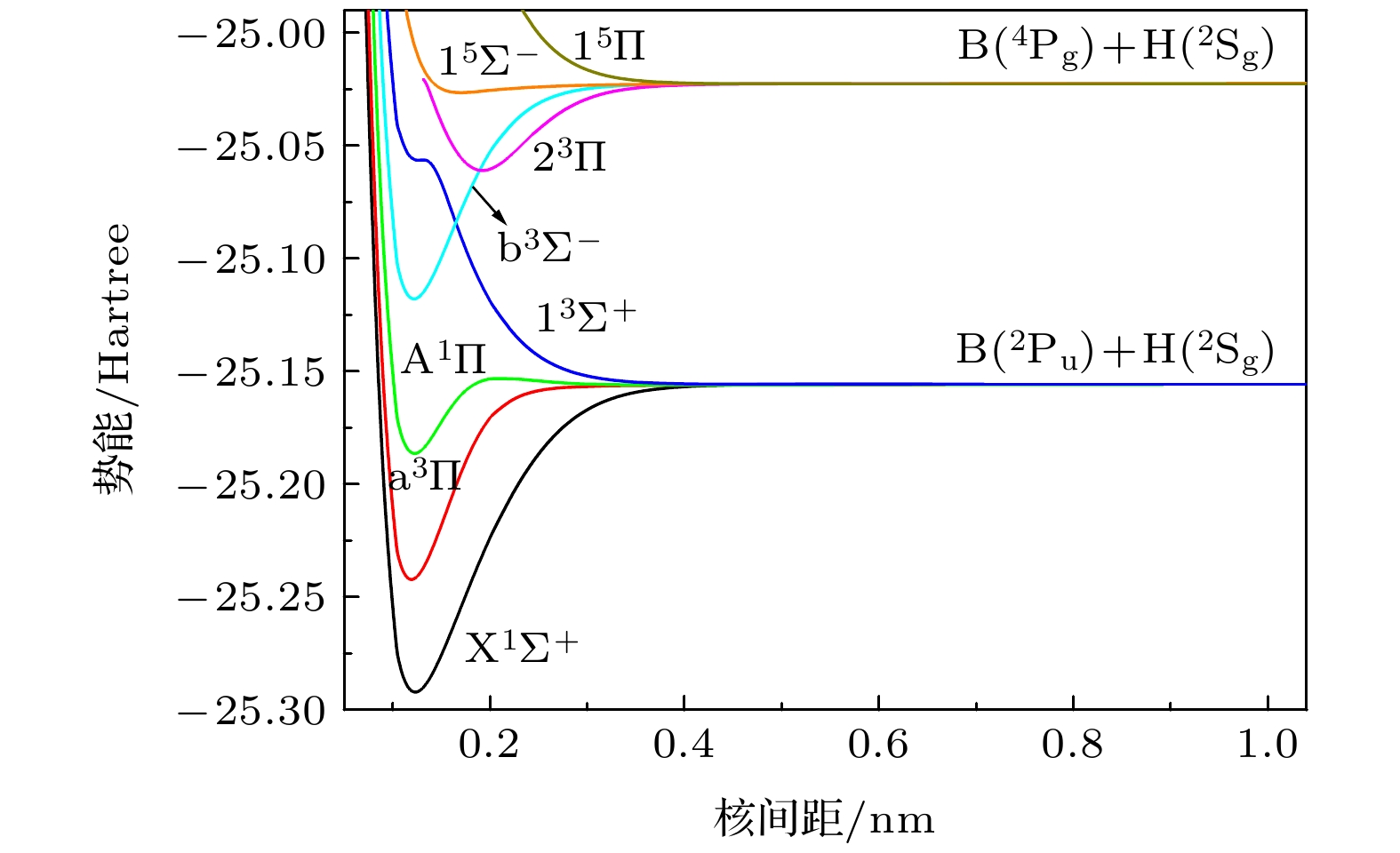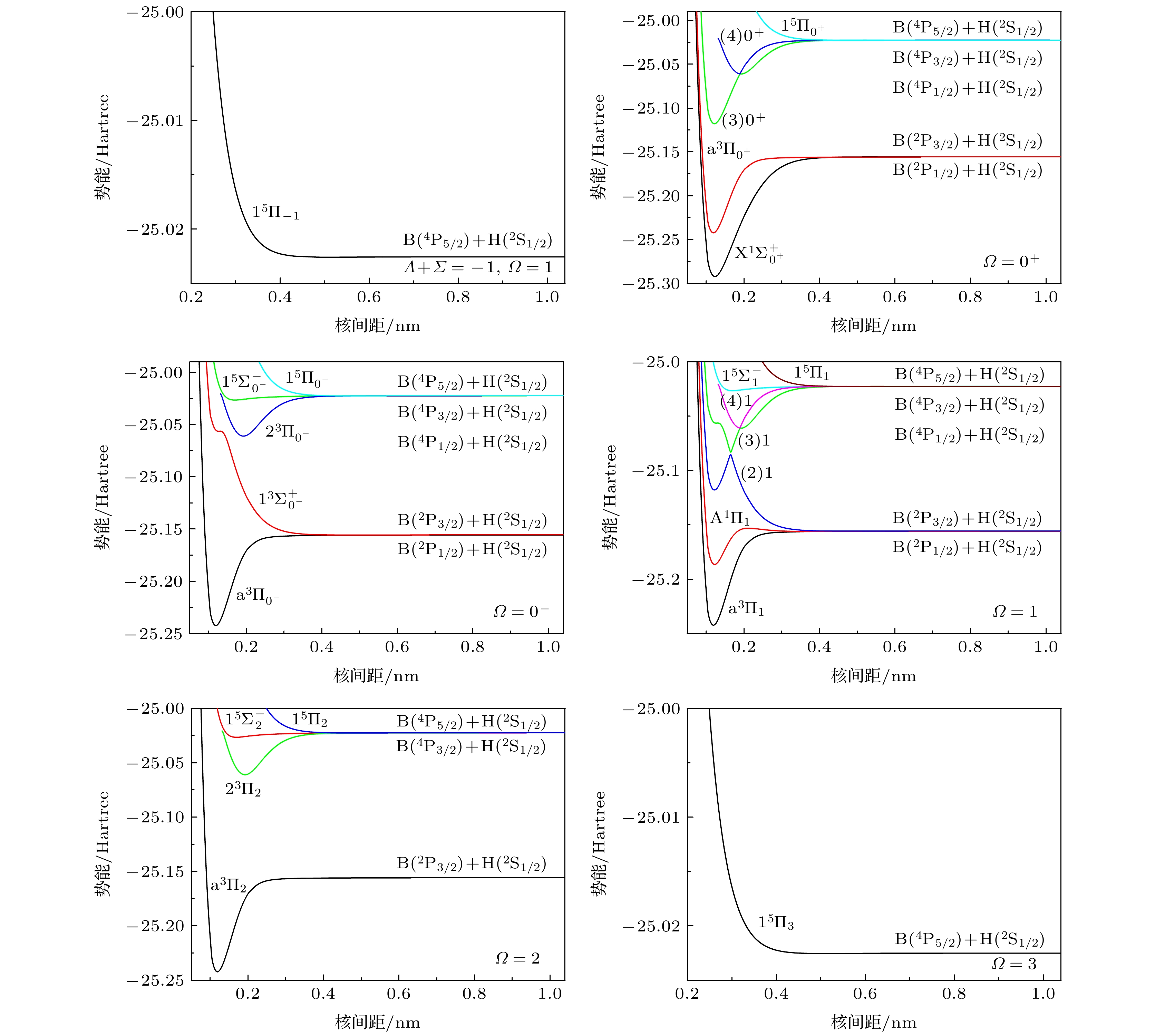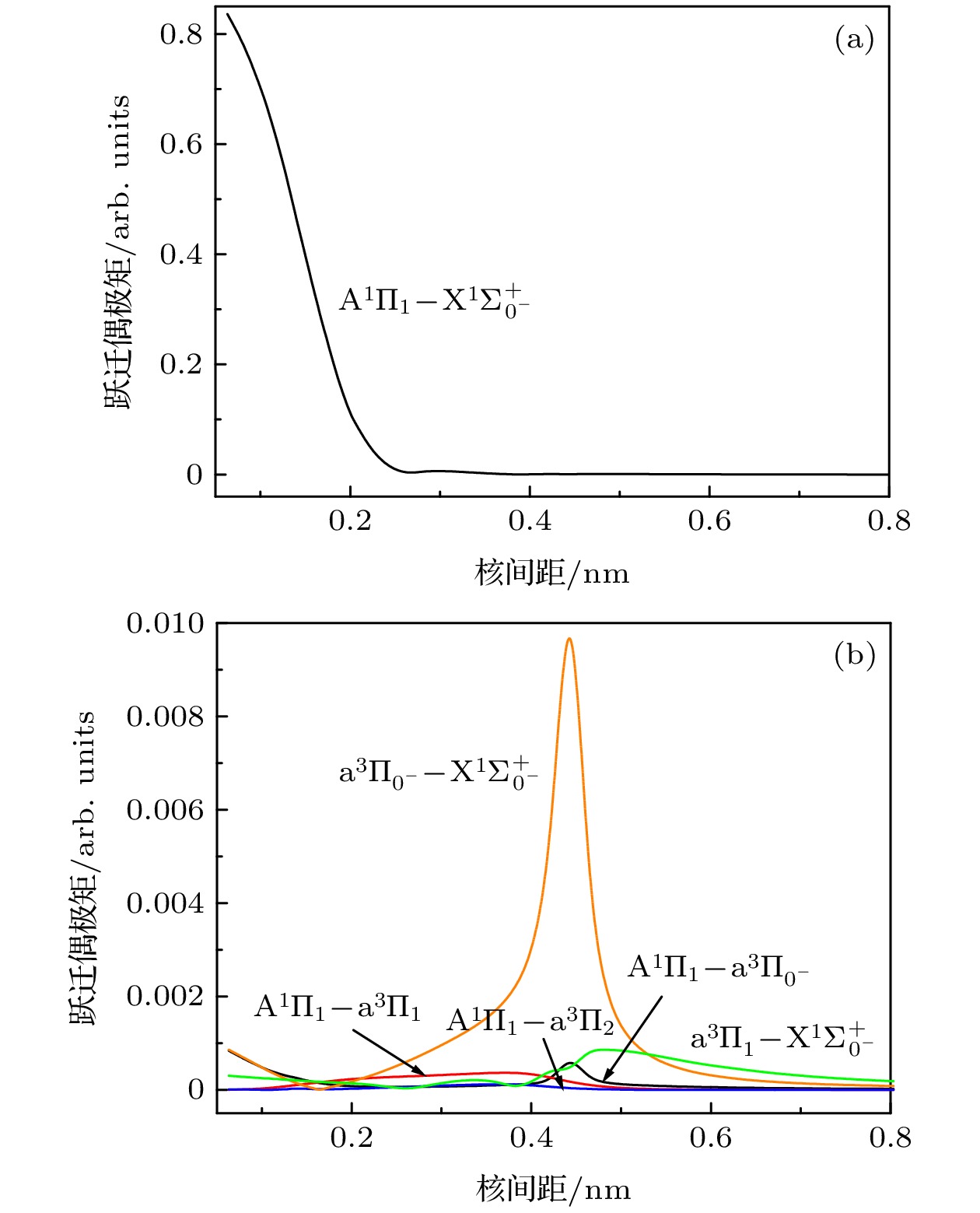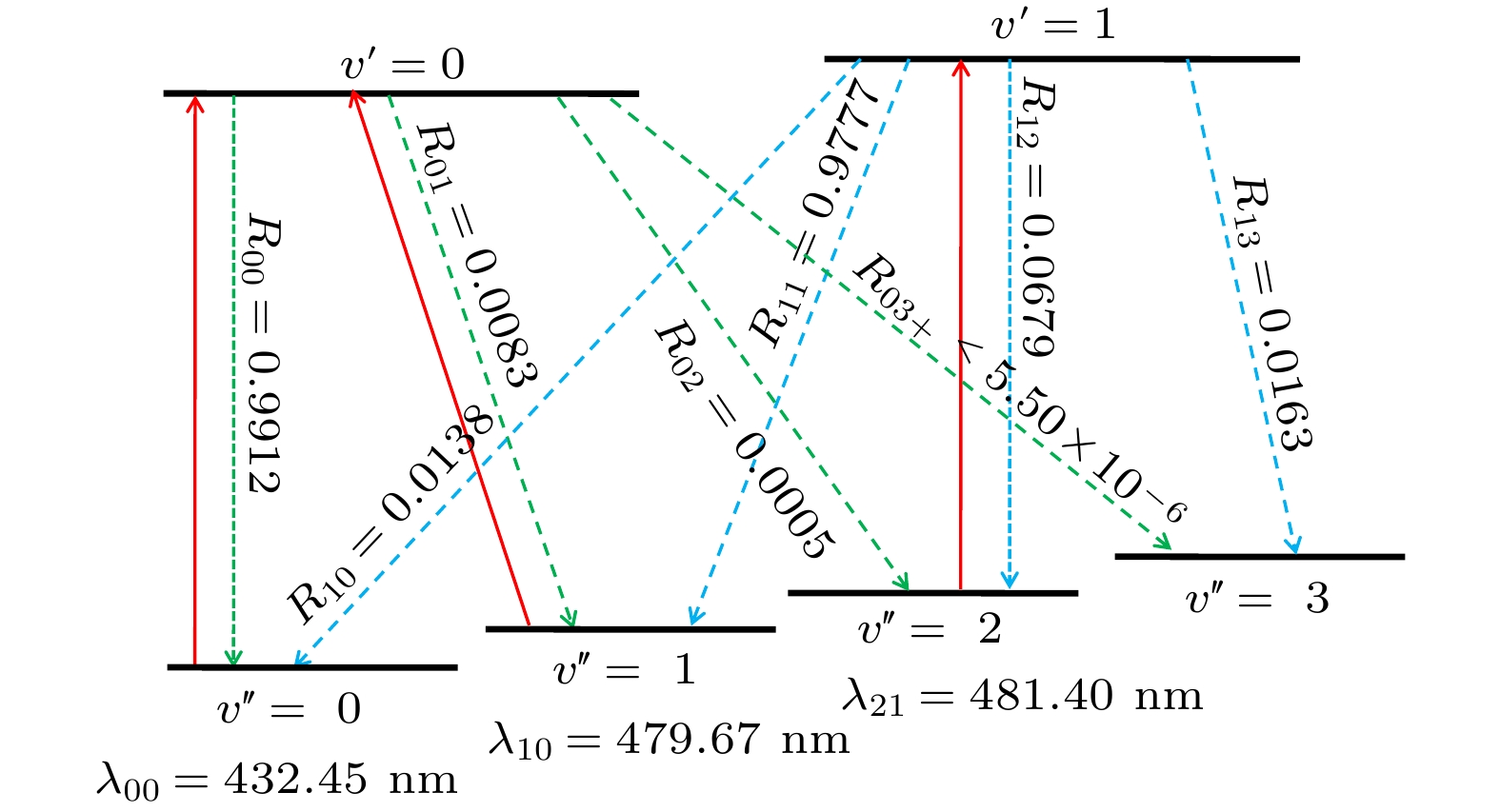-
In this work, the potential energy curves of eight low electronic states (X1Σ+, a3Π, A1Π, b3Σ-, 23Π, 13Σ+, 15Σ-, and 15Π) and twenty-three Ω states of BH molecule, and the transition dipole moments among the
$ {\text{X}}{}^{\text{1}}{\Sigma}_{{{\text{0}}^ + }}^ + $ ,$ {{\text{a}}^{\text{3}}}{\Pi_{{{\text{0}}^ + }}} $ , a3Π1, a3Π2, and A1Π1 states are calculated by using the internally contracted multireference configuration interaction (icMRCI) method. In order to obtain the accurate potential energy curve, the errors caused by single and double electron excitation, core-valence correlation effects, relativistic effects and basis set truncation are corrected. The spectral and transition data of BH molecule are in good agreement with the available theoretical and experimental data. The calculation results show that the A1Π1(υ′ = 0-2, J′ = 1, +) →$ {\text{X}}{}^{\text{1}}{\Sigma}_{{{\text{0}}^ + }}^ + $ (υ′′ = 0-2, J′′ = 1, –) transition has large Einstein A-coefficient, weighted absorption oscillator strength, and highly diagonal vibrational branching ratio Rυ′υ′′, and the excited state A1Π1(υ′ = 0, 1) have short spontaneous radiation lifetimes. Moreover, the effects of$ {{\text{a}}^{\text{3}}}{\Pi_{{{\text{0}}^ + }}} $ and a3Π1 states on A1Π1(υ′ = 0) ↔$ {\text{X}}{}^{\text{1}}{\Sigma}_{{{\text{0}}^ + }}^ + $ (υ′′ = 0) cycle transition can be ignored. Therefore, according to the A1Π1(υ′ = 0-1, J′ = 1, +) ↔$ {\text{X}}{}^{\text{1}}{\Sigma}_{{{\text{0}}^ + }}^ + $ (υ′′ = 0-3, J′′ = 1, –) cycle transition, we propose to apply one main cooling laser (λ00 = 432.45 nm) and two repumping lasers (λ10 = 479.67 nm and λ21 = 481.40 nm) to laser cooling BH molecules, and evaluation of the cooling effect.-
Keywords:
- potential energy curves /
- spectroscopic parameters /
- spin-orbit coupling /
- transition dipole moments
[1] Engvold O 1970 Sol. Phys. 11 183
 Google Scholar
Google Scholar
[2] Karthikeyan B, Raja V, Rajamanickam N, Bagare S P 2006 Astrophys. Space. Sci. 306 231
 Google Scholar
Google Scholar
[3] Karthikeyan B, Bagare S P, Rajamanickam N, Raja V 2009 Astropart. Phys. 31 6
 Google Scholar
Google Scholar
[4] Hendricks R J, Holland D A, Truppe S, Sauer B E, Tarbutt M R 2014 Front. Phys. 2 51
 Google Scholar
Google Scholar
[5] Gao Y F, Gao T 2015 Phys. Chem. Chem. Phys. 17 10830
 Google Scholar
Google Scholar
[6] Johns J W C, Grimm F A, Porter R F 1967 J. Mol. Spectrosc. 22 435
 Google Scholar
Google Scholar
[7] Luh W T, StwalleyW C 1983 J. Mol. Spectrosc. 102 212
 Google Scholar
Google Scholar
[8] Pianalto F S, O’Brien L C, Keller P C, Bernath P F 1988 J. Mol. Spectrosc. 129 348
 Google Scholar
Google Scholar
[9] Douglass C H, Nelson H H, Rice J K 1989 J. Chem. Phys. 90 6940
 Google Scholar
Google Scholar
[10] Fernando W T M L, Bernath P F 1991 J. Mol. Spectrosc. 145 392
 Google Scholar
Google Scholar
[11] Persico M 1994 Mol. Phys. 81 1463
 Google Scholar
Google Scholar
[12] Clark J, Konopka M, Zhang L M, Grant E R 2001 Chem. Phys. Lett. 340 45
 Google Scholar
Google Scholar
[13] Shayesteh A, Ghazizadeh E 2015 J. Mol. Spectrosc. 312 110
 Google Scholar
Google Scholar
[14] Brazier C R 1996 J. Mol. Spectrosc. 177 90
 Google Scholar
Google Scholar
[15] Petsalakis I D, Theodorakopoulos G 2006 Mol. Phys. 104 103
 Google Scholar
Google Scholar
[16] Petsalakis I D, Theodorakopoulos G 2007 Mol. Phys. 105 333
 Google Scholar
Google Scholar
[17] Miliordos E, Mavridis A 2008 J. Chem. Phys. 128 144308
 Google Scholar
Google Scholar
[18] 王新强, 杨传路, 苏涛, 王美山 2009 物理学报 58 6873
 Google Scholar
Google Scholar
Wang X Q, Yang C L, Su T, Wang M S 2009 Acta Phys. Sin. 58 6873
 Google Scholar
Google Scholar
[19] Koput J 2015 J. Comput. Chem. 36 2219
 Google Scholar
Google Scholar
[20] Yan P Y, Yan B 2016 Commun. Comput. Chem. 4 109
 Google Scholar
Google Scholar
[21] Werner H J, Knowles P J, Lindh R, Manby F R, Schütz M 2010 MOLPRO, version 2010.1, a package of ab initio programs, http://www.molpro.net [2021–12–8]
[22] Van Mourik T, Dunning Jr T H 2000 Int. J. Quantum Chem. 76 205
 Google Scholar
Google Scholar
[23] Langhoff S R, Davidson E R 1974 Int. J. Quantum Chem. 8 61
 Google Scholar
Google Scholar
[24] Peterson K A, Dunning Jr T H 2002 J. Chem. Phys. 117 10548
 Google Scholar
Google Scholar
[25] De Jong W A, Harrison R J, Dixon D A 2001 J. Chem. Phys. 114 48
 Google Scholar
Google Scholar
[26] Wolf A, Reiher M, Hess B A 2002 J. Chem. Phys. 117 9215
 Google Scholar
Google Scholar
[27] Oyeyemi V B, Krisiloff D B, Keith J A, Libisch F, Pavone M, Carter E A 2014 J. Chem. Phys. 140 044317
 Google Scholar
Google Scholar
[28] Berning A, Schweizer M, Werner H J, Knowles P J, Palmieri P 2000 Mol. Phys. 98 1823
 Google Scholar
Google Scholar
[29] Le Roy R J 2017 J. Quant. Spectrosc. Radiat. Transf 186 167
[30] Kramida A E, Ryabtsev A N 2007 Phys. Scr. 76 544
 Google Scholar
Google Scholar
[31] Strasburger K 2020 Phys. Rev. A 102 052806
 Google Scholar
Google Scholar
[32] Di Rosa M D 2004 Eur. Phys. J. D 31 395
 Google Scholar
Google Scholar
[33] Hummon M T, Yeo M, Stuhl B K, Collopy A L, Xia Y, Ye J 2013 Phys. Rev. Lett. 110 143001
 Google Scholar
Google Scholar
-
图 4 利用A1Π1(υ′) ↔
$ {\text{X}}{}^{\text{1}}{\Sigma}_{{{\text{0}}^ + }}^ + $ (υ′′)跃迁进行激光冷却BH分子的方案. 虚线表示A1Π1(υ′ = 0, 1) →$ {\text{X}}{}^{\text{1}}{\Sigma}_{{{\text{0}}^ + }}^ + $ (υ′′ = 0 –3)跃迁的自发辐射振动分支比(Rυ′υ′′). 红色实线表示激光驱动$ {\text{X}}{}^{\text{1}}{\Sigma}_{{{\text{0}}^ + }}^ + $ (υ′′) → A1Π1 (υ′)跃迁Figure 4. The proposed laser cooling scheme for the BH using A1Π1(υ′) ↔
$ {\text{X}}{}^{\text{1}}{\Sigma}_{{{\text{0}}^ + }}^ + $ (υ′′) transition. The dotted line indicate the spontaneous radiation vibrational branching ratio (Rυ′υ′′) of A1Π1(υ′ = 0, 1) →$ {\text{X}}{}^{\text{1}}{\Sigma}_{{{\text{0}}^ + }}^ + $ (υ′′ = 0 – 3) transition. The red solid line indicate the wavelength (λυ′′υ′) at which the laser drives the$ {\text{X}}{}^{\text{1}}{\Sigma}_{{{\text{0}}^ + }}^ + $ (υ′′) →A1Π1 (υ′). transition.表 1 BH分子前两个离解极限产生的8个Λ-S态的离解关系
Table 1. Dissociation relationships of the 8 Λ –S states generated from the first two dissociation asymptotes of the BH molecule
表 2 icMRCI + Q/56 + CV + SR理论水平上BH分子7个Λ-S态的光谱常数
Table 2. Spectroscopic parameters of the 7 Λ-S states of BH at level of icMRCI + Q/56 + CV + SR.
Λ-S态 来源 Te/cm–1 Re/nm ωe/cm–1 ωexe/cm–1 Be/cm–1 αe/(102 cm–1) De/eV X1Σ+ 本文 0 0.12295 2367.28 48.7782 12.0395 37.0985 3.7137 实验[8] 0 0.12322 2366.73 49.3384 12.0255 42.1516 实验[10] 0 — 2366.73 49.3398 12.0258 42.1565 实验[12] 0 — 2364.66 47.7098 12.0257 42.1591 3.6476±0.0037a 实验[13] 0 0.12322 2366.73 49.3405 12.0255 42.1450 理论[5] 0 0.12290 2352.0 44.0 12.086 — 3.6863 理论[15] 0 0.12301 2379 46.79 12.07 — 3.70 理论[16] 0 0.12312 2378 12.055 3.578b 理论[17] 0 0.1230 2359 48.8 — 41.8 3.6773 理论[18] 0 0.12327 2368.48 50.6957 12.110 43.05 3.6580 理论[19] 0 0.12300 — — — — 3.6751 理论[20] 0 0.12293 2365.69 47.2310 12.0801 41.6 3.6851 a3Π 本文 10944.32 0.11899 2625.97 59.4177 12.8919 41.6404 2.3507 实验[14] xc 0.11900 2625.14 55.7840 12.8931 41.5610 2.3867 理论[5] 10645.0 0.11900 2961.0 109.6 12.904 — 2.3806 理论[15] 0.11913 2653 62.70 12.87 — 2.38 理论[17] 10583 0.11900 2625 60.4 — 45.5 2.3677 理论[18] 9557.67 0.11925 2598.98 46.6300 12.9400 42.53 2.3135 A1Π 本文 23203.52 0.12223 2253.28 36.8310 11.8343 11.6254 0.8368 实验[10] 23135.44 0.12195d 2251.46 56.5725 12.20035 53.7670 0.697d 实验[12] 23105.10 — 2342.41 127.7618 12.19986 53.6736 0.7786±0.0037a 理论[5] 22997.90 0.12210 2404.60 147.3 12.2795 — 0.9098 理论[15] 0.12213 2320 136.5 12.24 — 0.71 理论[16] 23061 0.12235 2290 — 12.20 — 0.73b 理论[17] 23144 0.1222 2341 129.6 — 85.1 0.8109 理论[18] 22260.89 0.12267 2280.26 93.6233 12.229 60.83 0.7536 理论[19] 23099.84 0.12212 2343.96 128.178 12.2836 74.0 0.8938 b3Σ– 本文 38238.63 0.12164 2440.89 54.4477 12.2508 33.6712 2.5959 实验[14] xc+27152.75 0.121625 2438.10 55.562 12.3426 43.087 2.5987 理论[15] 0.12256 2345 48.45 12.16 — 2.54 理论[17] 37708 0.1217 2430 57.3 — 45.9 2.5845 理论[18] 36859.52 0.12199 2428.33 55.409 12.284 44.31 2.5403 23Π 本文 50730.46 0.19215 1273.89 20.7896 4.94471 3.0957 1.0467 理论[15] 0.19338 1425 57.04 4.88 — 1.04 理论[17] 50216 0.1931 1295 38.6 — 9.9 1.0321 13Σ+ 本文 51738.07 0.12592 — — — — 0.0031 理论[17] 51688 0.123 15Σ– 本文 58295.54 0.16981 634.868 167.676 6.51936 192.641 0.1093 理论[17] 57674 0.1701 528 87.3 — 153.2 0.1084 a, 文献[11]中的值; b, D0值; c, x表示a3Π态相对于X1Σ+态的Te值; d, 文献[7]中的值. 表 3 BH分子23个Ω态的离解关系
Table 3. Dissociation relationships of the 23 Ω states of the BH molecule.
原子态(B + H) Ω态 能级/cm–1 本文 实验[30] B(2P1/2) + H(2S1/2) 0–, 0+, 1 0.00 0.00 B(2P3/2) + H(2S1/2) 2, 1(2), 0+, 0– 14.572 15.287 B(4P1/2) + H(2S1/2) 0–, 0+, 1 28910.63 28647.43+x a B(4P3/2) + H(2S1/2) 2, 1(2), 0+, 0– 28914.67 28652.07+x a B(4P5/2) + H(2S1/2) 3, 2(2), 1(2), 0+, 0– 28921.41 28658.40+x a a, 4P5/2能级外推值的不确定度. 表 4 利用icMRCI + Q/56 + CV + SR + SOC理论计算获得的17个Ω态的光谱常数
Table 4. Spectroscopic parameters obtained by the icMRCI + Q/56 + CV + SR + SOC calculations for the 17 Ω states.
Ω态 Te/cm–1 Re/nm ωe/cm–1 ωexe/cm–1 Be/cm–1 102αe/cm–1 De/eV 在Re附近主要的Λ–S态/% $ {\text{X}}{}^{\text{1}}{\Sigma}_{{{\text{0}}^ + }}^ + $ 0 0.12295 2367.28 48.7783 12.0395 37.0985 3.7138 X1Σ+ (100.00) ${\text{a} }{}^{\text{3} }{\Pi_{ { {\text{0} }^{{ - } } } }}$ 10940.36 0.11899 2625.93 59.4165 12.8918 41.6426 2.3506 a3Π (100.00) $ {\text{a}}{}^{\text{3}}{\Pi_{{{\text{0}}^ + }}} $ 10940.37 0.11899 2625.93 59.4192 12.8918 41.6424 2.3506 a3Π (100.00) a3Π1 10944.32 0.11899 2625.97 59.4140 12.8919 41.6403 2.3513 a3Π (100.00) a3Π2 10948.49 0.11899 2626.01 59.4131 12.8919 41.6384 2.3509 a3Π (100.00) A1Π1 23203.52 0.12223 2253.28 36.8317 11.8338 11.7034 0.9051 A1Π (100.00) (3)0+第一势阱 38244.33 0.12163 2438.08 44.7281 12.2925 38.3041 1.5501 b3Σ– (100.00) (3)0+第二势阱 50725.86 0.19213 — — — — 0.0026 23Π (100.00) (3)1 38244.35 0.12163 2447.69 54.2934 12.3167 37.6149 0.8995 b3Σ– (100.00) (4)1 45758.49 0.16496 4850.09 1293.00 6.73952 4.02168 1.6629 13Σ+ (100.00) ${\text{2} }{}^{\text{3} }{\Pi_{ { {\text{0} }^{ { - } } } } }$ 50726.07 0.19214 1274.00 20.8450 4.94470 3.09611 1.0466 23Π (100.00) (4)0+ 50726.51 0.18860 2344.54 77.7976 16.5616 29.6976 1.0478 b3Σ– (99.82), 23Π (0.18) (5)1 50728.05 0.18863 2531.33 412.671 5.20415 61.4752 1.0476 b3Σ– (99.92), 23Π (0.08) 23Π2 50734.85 0.19215 1273.86 20.7903 4.94471 3.09520 1.0467 23Π (100.00) ${\text{1} }{}^{\text{3} }{\Sigma}_{ { {\text{0} }^{{ - } } } }^ +$ 51738.08 0.12592 — — — — 0.0031 13Σ+ (100.00) ${\text{1} }{}^{\text{5} }{\Sigma}_{ { {\text{0} }^{{ - } } } }^{{ - } }$ 58295.53 0.16981 634.857 167.653 6.51872 192.471 0.1096 15Σ– (100.00) ${\text{1} }{}^{\text{5} }{\Sigma}_{\text{2} }^{{ - } }$ 58295.55 0.16981 634.862 167.660 6.51884 192.502 0.1096 15Σ– (100.00) ${\text{1} }{}^{\text{5} }{\Sigma}_{\text{2} }^{{ - } }$ 58295.57 0.16981 634.867 167.669 6.51902 192.550 0.1095 15Σ– (100.00) 表 5 A1Π1(υ′, J′ = 1, +) →
$ {\text{X}}{}^{\text{1}}{\Sigma}_{{{\text{0}}^ + }}^ + $ (υ′′, J′′ = 1, –)跃迁的跃迁波数(${\tilde v} $ )、爱因斯坦A系数(Aυ′υ′′)、振动分支比(Rυ′υ′′)、波长(λυ′υ′′)、加权的吸收振子强度(gfυ′υ′′)Table 5. The transition wavenumber (
${\tilde v} $ ), Einstein A-coefficients (Aυ′υ′′), vibrational branching ratios (Rυ′υ′′), wavelength (λυ′υ′′), and weighted absorption oscillator strengths (gfυ′υ′′) for the A1Π1(υ′, J′ = 1, +) →$ {\text{X}}{}^{\text{1}}{\Sigma}_{{{\text{0}}^ + }}^ + $ (υ′′, J′′ = 1, –) transitions.υ′–υ″ ${\tilde v}/$cm–1 Aυ′υ′′/s Rυ′υ′′ λυ′υ′′/nm gfυ′υ′′ υ′–υ″ ${\tilde v} $/cm–1 Aυ′υ′′/s Rυ′υ′′ λυ′υ′′/nm gfυ′υ′′ 0-0 23140.44 7.98×106 0.9912 432.45 0.0067 1-0 25243.77 9.61×104 0.0138 396.42 6.78×10–4 0-1 20862.55 6.67×104 0.0083 479.67 6.89×10–4 1-1 22965.88 6.80×106 0.9777 435.74 0.0580 0-2 18684.36 3.86×103 4.79×10–4 535.59 4.97×10–5 1-2 20787.69 4.72×104 0.0068 481.40 4.91×10–4 0-3 16602.97 4.43×101 5.50×10–6 602.73 7.22×10–7 1-3 18706.30 1.13×104 0.0016 534.96 1.45×10–4 0-4 14612.08 1.75 2.17×10–7 684.85 3.69×10–8 1-4 16715.40 7.15×101 1.03×10–5 598.68 1.15×10–6 2-0 27090.98 1.76×103 3.10×10–4 369.39 1.08×10–5 3-0 28588.60 1.08×103 2.66×10–4 350.04 5.95×10–6 2-1 24813.09 4.31×105 0.0759 403.30 0.0032 3-1 26310.72 1.89×103 4.66×10–4 380.34 1.23×10–5 2-2 22634.90 5.22×106 0.9192 442.11 0.0458 3-2 24132.53 1.16×106 0.2858 414.67 0.0090 2-3 20553.51 1.38×103 2.43×10–4 486.88 1.47×10–5 3-3 22051.13 2.80×106 0.6887 453.81 0.0259 2-4 18562.62 2.46×104 0.0043 539.10 3.21×10–4 3-4 20060.24 4.31×104 0.0106 498.85 4.82×10–4 2-5 16658.64 1.50×101 2.64×10–6 600.72 2.43×10–7 3-5 18156.26 5.40×104 0.1330 551.17 7.37×10–4 表 7 a3Π1(υ′, J′ = 1, +) →
$ {\text{X}}{}^{\text{1}}{\Sigma}_{{{\text{0}}^ + }}^ + $ (υ′′, J′′ = 1, –)跃迁的跃迁波数(${\tilde v} $ )、爱因斯坦A系数(Aυ′υ′′)、振动分支比(Rυ′υ′′)、波长(λυ′υ′′)、加权的吸收振子强度(gfυ′υ′′)Table 7. The transition wavenumber (
${\tilde v} $ ), Einstein A-coefficients(Aυ′υ′′), vibrational branching ratios (Rυ′υ′′), wavelength (λυ′υ′′), and weighted absorption oscillator strengths (gfυ′υ′′) for the a3Π1(υ′, J′ = 1, +) →$ {\text{X}}{}^{\text{1}}{\Sigma}_{{{\text{0}}^ + }}^ + $ (υ′′, J′′ = 1, –).υ′–υ″ ${\tilde v} $/cm–1 Aυ′υ′′/s Rυ′υ′′ λυ′υ′′/nm gfυ′υ′′ υ′–υ″ ${\tilde v} $/cm–1 Aυ′υ′′/s Rυ′υ′′ λυ′υ′′/nm gfυ′υ′′ 0-0 11039.58 0.1278 0.9615 906.48 4.72×10–9 1-0 13546.43 0.0081 0.0607 738.73 1.98×10–10 0-1 8761.69 0.0050 0.0374 1142.14 2.91×10–10 1-1 11268.54 0.1148 0.8613 888.06 4.07×10–9 0-2 6583.50 1.48×10–4 0.0011 1520.03 1.54×10–11 1-2 9090.35 0.0099 0.0739 1100.85 5.36×10–10 0-3 4502.11 3.00×10–6 2.25×10–5 2222.76 6.65×10–13 1-3 7008.96 5.33×10–4 0.0040 1427.76 4.88×10–11 0-4 2511.21 3.32×10–8 2.50×10–7 3984.98 2.37×10–14 1-4 5018.07 1.86×10–5 1.39×10–4 1994.22 3.32×10–12 2-0 15928.88 2.81×10–5 2.12×10–4 628.24 4.98×10–13 3-0 18182.60 1.94×10–6 1.47×10–5 550.37 2.63×10–14 2-1 13651.00 0.0152 0.1142 733.07 3.66×10–10 3-1 15904.71 5.54×10–5 4.22×10–4 629.19 9.84×10–13 2-2 11472.81 0.1023 0.7703 872.25 3.49×10–9 3-2 13726.52 0.0211 0.1607 729.04 5.04×10–10 2-3 9391.41 0.0141 0.1059 1065.56 7.17×10–10 3-3 11645.13 0.0912 0.6945 859.34 3.03×10–9 2-4 7400.52 0.0012 0.0089 1352.22 9.71×10–11 3-4 9654.23 0.0168 0.1277 1036.55 8.09×10–10 表 6
$ {{\text{a}}^{\text{3}}}{\Pi_{{{\text{0}}^ + }}} $ (υ′, J′ = 0, + ) →$ {\text{X}}{}^{\text{1}}{\Sigma}_{{{\text{0}}^ + }}^ + $ (υ′′, J′′ = 1, –)跃迁的跃迁波数(${\tilde v} $ )、爱因斯坦A系数(Aυ′υ′′)、振动分支比(Rυ′υ′′)、波长(λυ′υ′′)、加权的吸收振子强度(gfυ′υ′′)Table 6. The transition wavenumber(
${\tilde v} $ ), Einstein A-coefficients(Aυ′υ′′), vibrational branching ratios (Rυ′υ′′), wavelength (λυ′υ′′), and weighted absorption oscillator strengths (gfυ′υ′′) for the$ {{\text{a}}^{\text{3}}}{\Pi_{{{\text{0}}^ + }}} $ (υ′, J′ = 0, + ) →$ {\text{X}}{}^{\text{1}}{\Sigma}_{{{\text{0}}^ + }}^ + $ (υ′′, J′′ = 1, –) transitions.υ′–υ″ ${\tilde v} $/cm–1 Aυ′υ′′/s Rυ′υ′′ λυ′υ′′/nm gfυ′υ′′ υ′–υ″ ${\tilde v} $/cm–1 Aυ′υ′′/s Rυ′υ′′ λυ′υ′′/nm gfυ′υ′′ 0-0 11039.10 0.1878 0.8913 906.52 2.31×10–9 1-0 13546.35 5.67×10–4 0.0030 738.73 4.63×10–12 0-1 8761.22 0.0216 0.1027 1142.21 4.22×10–10 1-1 11268.46 0.1441 0.7666 888.06 1.70×10–9 0-2 6583.03 0.0012 0.0058 1520.14 4.24×10–11 1-2 9090.27 0.0391 0.2082 1100.86 7.10×10–10 0-3 4501.63 4.60×10–5 2.18×10–4 2223.00 3.40×10–12 1-3 7008.88 0.0039 0.0209 1427.78 1.20×10–10 0-4 2510.74 9.71×10–7 4.61×10–6 3985.72 2.31×10–13 1-4 5017.98 2.33×10–4 0.0012 1994.25 1.39×10–11 2-0 15929.21 3.36×10–4 0.0020 628.22 1.98×10–12 3-0 18183.37 1.76×10–6 1.12×10–5 550.34 7.97×10–15 2-1 13651.32 0.0023 0.0142 733.05 1.84×10–11 3-1 15905.48 9.50×10–4 0.0061 629.16 5.63×10–12 2-2 11473.13 0.1081 0.6354 872.22 1.23×10–9 3-2 13727.29 0.0050 0.0320 728.99 3.99×10–11 2-3 9391.74 0.0507 0.2982 1065.52 8.62×10–10 3-3 11645.90 0.0817 0.5216 859.28 9.03×10–10 2-4 7400.84 0.0080 0.0468 1352.16 2.18×10–10 3-4 9655.01 0.0542 0.3464 1036.47 8.72×10–10 表 8 A1Π1(υ′, J′ = 1, +),
$ {{\text{a}}^{\text{3}}}{\Pi _{{0^ + }}} $ (υ′, J′ = 0, + )和a3Π1(υ′, J′ = 1, +)态的辐射寿命(τυ’)Table 8. Spontaneous radiative lifetimes(τυ′) for the A1Π1(υ′, J′ = 1, +),
$ {{\text{a}}^{\text{3}}}{\Pi _{{0^ + }}} $ (υ′, J′ = 0, +)和a3Π1(υ′, J′ = 1, +) transitionsυ′ $ {\text{a}}{}^{\text{3}}{\Pi_{{{\text{0}}^ + }}} $/s a3Π1/s A1Π1/ns 总和/ns $ {\text{A}}{}^{\text{1}}{\Pi_{\text{1}}}{\text{ - }}{{\text{X}}^{\text{1}}}{\Sigma}_{{{\text{0}}^ + }}^ + $/ns $ {\text{A}}{}^{\text{1}}{\Pi_{\text{1}}} $-$ {\text{a}}{}^{\text{3}}{\Pi_{{{\text{0}}^ + }}} $/s A1Π1– a3Π1/s A1Π1– a3Π2/s 0 4.75 7.52 124.18 124.18 2.71 111.48 177.04 1 5.32 7.50 143.86 143.86 3.03 90.08 116.30 2 5.88 7.53 176.12 176.12 3.58 83.05 192.36 3 6.39 7.61 246.20 246.20 4.77 93.55 255.19 4 6.85 7.78 5 7.27 8.09 -
[1] Engvold O 1970 Sol. Phys. 11 183
 Google Scholar
Google Scholar
[2] Karthikeyan B, Raja V, Rajamanickam N, Bagare S P 2006 Astrophys. Space. Sci. 306 231
 Google Scholar
Google Scholar
[3] Karthikeyan B, Bagare S P, Rajamanickam N, Raja V 2009 Astropart. Phys. 31 6
 Google Scholar
Google Scholar
[4] Hendricks R J, Holland D A, Truppe S, Sauer B E, Tarbutt M R 2014 Front. Phys. 2 51
 Google Scholar
Google Scholar
[5] Gao Y F, Gao T 2015 Phys. Chem. Chem. Phys. 17 10830
 Google Scholar
Google Scholar
[6] Johns J W C, Grimm F A, Porter R F 1967 J. Mol. Spectrosc. 22 435
 Google Scholar
Google Scholar
[7] Luh W T, StwalleyW C 1983 J. Mol. Spectrosc. 102 212
 Google Scholar
Google Scholar
[8] Pianalto F S, O’Brien L C, Keller P C, Bernath P F 1988 J. Mol. Spectrosc. 129 348
 Google Scholar
Google Scholar
[9] Douglass C H, Nelson H H, Rice J K 1989 J. Chem. Phys. 90 6940
 Google Scholar
Google Scholar
[10] Fernando W T M L, Bernath P F 1991 J. Mol. Spectrosc. 145 392
 Google Scholar
Google Scholar
[11] Persico M 1994 Mol. Phys. 81 1463
 Google Scholar
Google Scholar
[12] Clark J, Konopka M, Zhang L M, Grant E R 2001 Chem. Phys. Lett. 340 45
 Google Scholar
Google Scholar
[13] Shayesteh A, Ghazizadeh E 2015 J. Mol. Spectrosc. 312 110
 Google Scholar
Google Scholar
[14] Brazier C R 1996 J. Mol. Spectrosc. 177 90
 Google Scholar
Google Scholar
[15] Petsalakis I D, Theodorakopoulos G 2006 Mol. Phys. 104 103
 Google Scholar
Google Scholar
[16] Petsalakis I D, Theodorakopoulos G 2007 Mol. Phys. 105 333
 Google Scholar
Google Scholar
[17] Miliordos E, Mavridis A 2008 J. Chem. Phys. 128 144308
 Google Scholar
Google Scholar
[18] 王新强, 杨传路, 苏涛, 王美山 2009 物理学报 58 6873
 Google Scholar
Google Scholar
Wang X Q, Yang C L, Su T, Wang M S 2009 Acta Phys. Sin. 58 6873
 Google Scholar
Google Scholar
[19] Koput J 2015 J. Comput. Chem. 36 2219
 Google Scholar
Google Scholar
[20] Yan P Y, Yan B 2016 Commun. Comput. Chem. 4 109
 Google Scholar
Google Scholar
[21] Werner H J, Knowles P J, Lindh R, Manby F R, Schütz M 2010 MOLPRO, version 2010.1, a package of ab initio programs, http://www.molpro.net [2021–12–8]
[22] Van Mourik T, Dunning Jr T H 2000 Int. J. Quantum Chem. 76 205
 Google Scholar
Google Scholar
[23] Langhoff S R, Davidson E R 1974 Int. J. Quantum Chem. 8 61
 Google Scholar
Google Scholar
[24] Peterson K A, Dunning Jr T H 2002 J. Chem. Phys. 117 10548
 Google Scholar
Google Scholar
[25] De Jong W A, Harrison R J, Dixon D A 2001 J. Chem. Phys. 114 48
 Google Scholar
Google Scholar
[26] Wolf A, Reiher M, Hess B A 2002 J. Chem. Phys. 117 9215
 Google Scholar
Google Scholar
[27] Oyeyemi V B, Krisiloff D B, Keith J A, Libisch F, Pavone M, Carter E A 2014 J. Chem. Phys. 140 044317
 Google Scholar
Google Scholar
[28] Berning A, Schweizer M, Werner H J, Knowles P J, Palmieri P 2000 Mol. Phys. 98 1823
 Google Scholar
Google Scholar
[29] Le Roy R J 2017 J. Quant. Spectrosc. Radiat. Transf 186 167
[30] Kramida A E, Ryabtsev A N 2007 Phys. Scr. 76 544
 Google Scholar
Google Scholar
[31] Strasburger K 2020 Phys. Rev. A 102 052806
 Google Scholar
Google Scholar
[32] Di Rosa M D 2004 Eur. Phys. J. D 31 395
 Google Scholar
Google Scholar
[33] Hummon M T, Yeo M, Stuhl B K, Collopy A L, Xia Y, Ye J 2013 Phys. Rev. Lett. 110 143001
 Google Scholar
Google Scholar
Catalog
Metrics
- Abstract views: 3127
- PDF Downloads: 70
- Cited By: 0

















 DownLoad:
DownLoad:

























